You are the administrator of a SQL Server 2000 computer. You are configuring a database for an inventory application. The hard disks on your server are configured as shown in the exhibit.The operating system files are located on drive C. Your database wil
题目
You are the administrator of a SQL Server 2000 computer. You are configuring a database for an inventory application. The hard disks on your server are configured as shown in the exhibit.

The operating system files are located on drive C. Your database will store a maximum of 6 GB of data and requires a maximum of 2 GB of disk space for the transaction log.
You want to optimize database performance. What should you do?
A.Add a 2-GB transaction log to drive D, a 3-GB data file to drive E, and a 3-GB data file to drive F
B.Add a 1-GB transaction log to drive C, a 1-GB transaction log to drive D, a 3-GB data file to drive E, and a 3-GB data file to drive F
C.Add a 1-GB transaction log to drive E, a 1-GB transaction log to drive F, a 3-GB data file to drive E, and a 3-GB data file to drive F
D.Add a 2-GB transaction log to drive F, a 3-GB data file to drive D, and a 3-GB data file to drive E
相似问题和答案
第1题:
You are the database administrator of a SQL Server 2000 computer. The server contains your company's Accounts database. Hundreds of users access the database each day.
Because you have had power interruptions in the past, you want to perfect the physical integrity of the Accounts database. You do not want to slow down server operations.
What should you do?
A.Enable the torn page detection database option for each database.
B.Disable write caching on all disk controllers.
C.Ensure that write caching disk controllers have battery backups.
D.Create a database maintenance plan to check database integrity and make repairs each night.
解析:Explanation:Thescenariostatesthatpowerinterruptionshaveoccurredinthepast.Bybuyingabatterybackupsolutionforthediskcontrollersthepowerinterruptionproblemwouldbeprevented.IncorrectAnswers:A:Tornpagedetectionisareactivesolutionwhichwouldslowdownperformancesincerestoreswouldhavetobemade.Itwouldbettertouseapreventivesolution.Note:Tornpagedetection:Ifatornpageisdetected,thedatabasemustberestoredfrombackupbecauseitwillbephysicallyinconsistent.B:Cachingisveryimportforperformance.Disablingwrite-cachingwouldbeabadidea.D:Repairingthedatabaseeverynightisnotagoodsolution.Databaseerrorscannotbeaccepted.Itisbettertopreventtheprobleminsteadoftryingtofixitafterithashappened.
第2题:
You are the administrator of two Microsoft Windows 2000 advanced server computers. On these servers, you are configuring a database that will store accounting information for your company.
The data must be available at all times. Interruptions in data connectivity should not last longer than five minutes. Any changes to the database should not require you to reconfigure the client computers.
How should you configure the database?
A.Configure the database on the two servers as a SQL Server 2000 cluster.
B.Configure the database on one server, and then configure a standby database on the second server.
C.Configure the database on each server. Use Microsoft Distributed Transaction Coordinator to keep the two servers perfectly synchronized.
D.Configure the database as a federated database, and then partition half the data on each server.
解析:Explanation: SQL Server 2000 failover clustering provides high availability support by allowing us to configure one failover cluster to automatically, with no manual configuration, fail over to any other node in the failover cluster configuration. In this way, we minimize system downtime and provide high server availability during an operating system failure or a planned upgrade. Before SQL Server 2000 failover clustering can be set up, we must install Windows NT 4.0, Enterprise Edition, Windows 2000 Advanced Server or Windows 2000 Datacenter Server, and the Microsoft Cluster Service (MSCS).
In this scenario a cluster would be preferred to a standby server because it would be available immediately. A standby server on the other would require manual configuration and more time to become online.
Incorrect Answers:
B: A standby server would require you to reconfigure clients to allow it to connect to the standby server when the main server goes down. It would require at least several minutes of manual administration before the standby server would be operational. But the scenario requires that no reconfiguration of the client computers should be necessary. Therefore we should use a SQL Server 2000 cluster not a standby server.
Note: A standby server is a second server that contains a copy of the databases on the primary server and that can be brought online in the event of a primary server failure or due to scheduled maintenance on the primary server. This allows users to continue working with databases when the primary server becomes unavailable. When the primary server becomes available again, any changes to the standby server's copies of databases must be restored back to the primary server.
C: The Microsoft Distributed Transaction Coordinator coordinates distributed transactions, but would not increase availability.
Note: The Microsoft Distributed Transaction Coordinator (MS DTC) is a transaction manager that allows client applications to include several different sources of data in one transaction. MS DTC coordinates committing the distributed transaction across all the servers enlisted in the transaction.
An installation of SQL Server 2000 can participate in a distributed transaction by calling stored procedures on remote servers running SQL Server, automatically or explicitly promoting the local transaction to a distributed transaction and enlist remote servers in the transaction, and making distributed updates that update data on multiple OLE DB data sources. If these OLE DB data sources support the OLE DB distributed transaction interface, SQL Server 2000 can also enlist them in the distributed transaction. The MS DTC service coordinates the proper completion of the distributed transaction to ensure that either all of the updates on all the servers are made permanent, or, in the case of errors, all erased.
D: With Federated SQL Server 2000 servers, SQL Server 2000 databases can be spread across a group of autonomous database servers. These are capable of supporting the processing growth requirements of the largest Web sites and enterprise data-processing systems built with Microsoft Windows DNA, which divides the processing units of a data processing system into logical tiers. This however does not improve availability.
第3题:
Your network contains a database server named Server1 that runs Windows Server 2003 Service Pack 2 (SP2).Server1 has the following hardware configurations:·A single processor that supports hyper-threading·Dual processor motherboard·Two hard disks·2 GB of RAMThe first disk contains all the files for the operating system and applications. The second disk is empty.Hyper-threading is disabled in the BIOS.Users report a slow response when they query the database on Server1.You monitor Server1 for one day and receive the performance statistics shown in the following table.You need to improve database performance.What should you do? ()

A. Upgrade the RAM to 4 gb.
B. Install a second processor.
C. Enable hyper-threading in the bios.
D. Move the database to the second disk.
第4题:
You are the administrator of a SQL Server 2000 computer. The server contains a database named Acct. You purge the Acct database of old records and perform. a full backup. The database now uses 4 GB of space. The database files are configured as shown in the Acct Properties exhibit.

The server has two hard disks that are configured as shown in the Server Configuration exhibit.
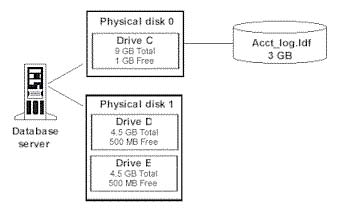
The 3 GB transaction log file for the Acct database is stored on drive C. You need to make room for a new database that has a 3 GB data file and a 1 GB transaction log file. You want to optimize database performance on both databases. You also want to minimize administrative overhead.
What should you do?
A.Shrink the empty data file on drive E. Place the new data file and the new log file on drive E.
B.Shrink the empty data file on drive E. Backup and shrink the log file on drive C to 2 GB. Place the new data file on drive E and the new log file on drive C.
C.Shrink the data file on drive D to 1 GB, and then shrink the data file on drive E to 2 GB. Place the new data file on drive D and the new log file on drive E.
D.Shrink and delete the data file on drive C, and then shrink the database files on drives D and E so that they are both 2 GB. Place the new data file and the new log file on drive C.
解析:Explanation: We must add a new 3GB database with a 1GB transaction log file. Currently we have database that is using 4GB for data and 3GB for the log file. We should place the log file and the data file on two different physical disks out of performance reasons.
The command DBCC SHRINKFILE with the EMPTYFILE option can be used to shrink a datafile to empty. The data will be migrated to the other files in the filegroup. We use this method to free 4.5 GB on Drive E. Then we backup the log file on C and reduce it to 2GB. Then we put the database data file on drive (3GB) and put the log file of the new database on drive C (1GB).
Incorrect answers:
A: It’s better to put the data file and the log file of the new database on two different physical disks out of performance reasons.
C: It’s better to put the data file and the log file of the new database on two different physical disks out of performance reasons.
D: It’s better to put the data file and the log file of the new database on two different physical disks out of performance reasons.
第5题:
You are the administrator of a SQL Server 2000 computer. Your company uses the server to store service contract information for its customers.
You are also the administrator of Oracle relational database management system (RDBMS) server.
This server is used to store your company’s financial information. The financial information is updated frequently throughout the day.
You need to create a series of reports that combine the service contract information and the financial information. These reports will be updated several times a day.
You want to create reports on the SQL Server computer by using the minimum amount of disk space.
What should you do?
A.Set up SQL server replication to replicate the data from the oracle server to the SQL server computer.
B.Set up the oracle server as a linked server. Create a view that joins the service contract information and the financial information.
C.Set up data transformation services (DTS) package that imports and transforms the database from the oracle server to the SQL server computer. Use SQL server agent to execute the DTS package throughout the day as needed.
D.Set up Microsoft ActiveX script. that connects to the oracle server and imports the financial information into SQL server temporary table. Create a view that joins the service contract information and the temporary table.
解析:Explanation: SQL Server 2000 permits the creation of links to OLE DB data sources called linked servers. After linking to an OLE DB data source, it is possible to reference rowsets from the OLE DB data sources as tables in Transact-SQL statements and to pass commands to the OLE DB data sources and include the resulting rowsets as tables in Transact-SQL statements.
Each distributed query can reference multiple linked servers and can perform. either update or read operations against each individual linked server. A single distributed query can perform. read operations against some linked servers and update operations against other linked servers. The Microsoft OLE DB Provider for Oracle allows distributed queries to query data in Oracle databases.
Incorrect Answers:
A: Replication allows for the coping, distribution, and modification of data across an enterprise. This involves the copying of database data from one server to another. This is not the best solution in this scenario as this will require frequent replication because the reports must be updated several times a day.
C: Data Transformation Services is a set of graphical tools and programmable objects that allows for the extraction, transformation, and consolidation of data from disparate sources into single or multiple destinations. In this scenario, however, the Oracle database needs to be included in a query. Hence, Data Transformation Services are inappropriate.
D: Microsoft ActiveX scripts can be used to add functionality to Data Transformation Services packages, which is a set of graphical tools and programmable objects that allows for the extraction, transformation, and consolidation of data from disparate sources into single or multiple destinations. In this scenario, however, the Oracle database needs to be included in a query. Hence, Data Transformation Services are inappropriate.
第6题:
You are an administrator of Ezonexam.com's network. You want to perform. routine upgrades on your Windows 2000 Server computer. You use your non-administrator user account in the domain to logon to the server.
You want to upgrade all of the critical system files and patches on the server in the shortest possible time.
What should you do?
A.Use Windows Update.
B.Run System File Checker.
C.Log on as administrator and run Windows Update.
D.Log on as administrator and run System File Checker.
解析:Explanation:WindowsUpdateisusedtoupgradethesystemfilesandtoretrieveandapplythelatestservicepacksandpatchesfortheoperatingsystem.AllnecessaryfilesaredownloadedthroughtheInternet.TobeabletorunWindowsUpdatewemusthaveadministrativerights.Incorrectanswers:A:Thenon-administrativeuseraccountcannotbeusedtorunWindowsUpdate.TorunWindowsUpdatewemusthaveadministrativerights.B:SystemFileCheckercheckstheintegrityofthesystemfiles.Itcannotbeusedtoupgradethesystemfilesortoretrieveandapplythelatestservicepacksandpatchesfortheoperatingsystem.D:SystemFileCheckercheckstheintegrityofthesystemfiles.Itcannotbeusedtoupgradethesystemfilesortoretrieveandapplythelatestservicepacksandpatchesfortheoperatingsystem.
第7题:
You are the administrator of a SQL server 2000 computer that contains a database named Acct. The database contains 1.5 GB of data. The server has one 9-GB hard disk that is configured as shown in the Exhibit.
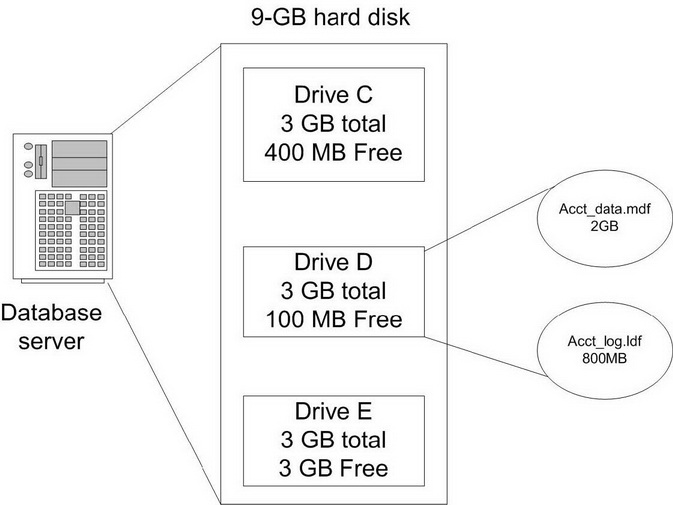
You need to import data into the database without adversely affecting database performance. The data will require an additional 2GB of storage space.
What should you do?
A.Add another data file on drive E, and then add the file to the PRIMARY filegroup.
B.Move the transaction log file to drive E, and set the file growth of Acc_Data.mdf by selecting the Unrestricted file growth option.
C.Rebuild all clustered indexes so that they have a fill factor of 100.
D.Compress drive D.
解析:Explanation: We must take precautions so that the import process of 2 GB data will run. We add a new file to drive E, which has 3 GB free disk space. By placing the new file in the primary file group we ensure that new data added to the database will be added to new data file. The primary file group is the default file group and new data is automatically added to it.
Incorrect Answers:
B: Moving the transaction log from Drive D to Drive would free up 800MB. This would leave 1.3GB of free disk space on drive D. But the import process will require another 2GB so we will not have enough free disk space.
C: Rebuilding the clustered indexes with a fill factor of 100 makes that the index pages full. This would degrade performance during the import process due to page splits.
D: Compressing a partition which is used by SQL Server is not a good idea. It would, if at all possible, degrade performance.
第8题:
You are the administrator of a SQL Server 2000 computer. You have two new hard disks on which you will create a database named inventory. You want to insert, update, and delete data as quickly as possible.
Which two actions should you take? (Each correct answer presents parts of the solution. Choose two)
A. Configure the hard disks as two mirrored NTFS volumes.
B. Configure the hard disks as one mirrored NTFS volumes.
C. Configure the hard disks as two independent NTFS volumes.
D. Configure the hard disks as one extended NTFS volume.
E. Place inventory_data.mdf on the first volume and inventory_log.ldf on the second volume.
F. Place inventory_data.mdf on the first volume and inventory_data2.ndf and inventory_log.ldf on the second volume.
G. Place inventory_data.mdf and inventory_log.ldf on the same volume.
C,E 解析:Explanation: Placing log files and the data files on different physical disks or independent volumes, and placing the log file of a drive that does not hold the operating system can improve database performance as it allows the frequently written to log file to exist a disk with its own read/write heads and thus less seek time.
Note: A Windows 2000 supports basic disks, in which physical disks are divided into partitions, and dynamic disks, in which disks are divided into volumes that can comprise an entire disk, two or more entire disks, portions of a disk, or portions of up to 32 physical disks.
A NTFS volume is volume that is formatted with the NTFS file system. Physical database design involves mapping the logical design onto physical media to allow for the data to be physically accessed and maintained as quickly as possible by taking advantage of the available hardware and software features. It is important to correctly design the database and to take advantage of hardware and software features early in the development cycle of a database application, because making changes to these components at a later stage it is difficult.
Incorrect Answers:
A: For redundancy and fault protection the log file can be placed on a mirrored volume. It would not be a good idea to put data files on a mirrored volume though. Performance when accessing the data would suffer.
Note: A mirrored volume is a fault-tolerant volume that duplicates data on two physical disks. It provides data redundancy as it copies the data on one volume to another volume on a different disk. When one of the physical disks fails, the data on the failed disk becomes unavailable, but the system can continue to operate by using the mirror disk. In such a set up, the data file and the log file will reside on the same drive. This will not improve database performance.
B: A mirrored volume cannot comprise of one volume only. It must comprise of two volumes on separate physical disks as a mirrored volume is a fault-tolerant volume that duplicates data on two physical disks. When one of the physical disks fails, the data on the failed disk becomes unavailable, but the system can continue to operate by using the mirror disk.
D: Data is written and read sequentially on extended volumes. As a result the data file and the log file will be placed on the same physical disk.
F: In this scenario the data file is separated into a primary data file, that uses the .mdf extension, and a secondary data file, that uses the .ndf extension. However, the secondary data file is placed on the same volume as the log file. This will lead to performance improvements only in cases where data is not read from the secondary data file.
G: Placing the data file and the log file on the same volume will not improve database performance as it will not allow parallel processing.
第9题:
You are the administrator of a SQL Server 2000 computer. The server contains database named Sales. Users report that they cannot add new data to the database. You examine the properties of the database. The database is configured as shown in the Sales Properties exhibit.

You examine drive E. The hard disk is configured as shown in the Local Disk Properties exhibit.
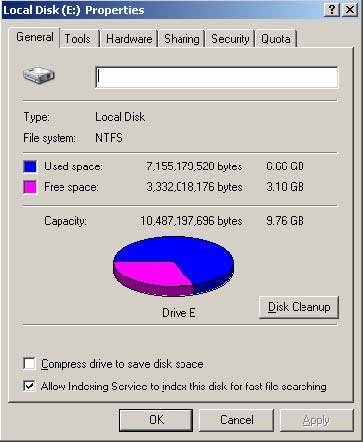
You want the users to be able to add data, and you want to minimize administrative overhead. What should you do?
A.Increase the maximum file size of Sales_Data to 1,500MB.
B.Use the DBCC SHRINKDATABASE statement.
C.Set automatic file growth to 10 percent.
D.Create another data file named Sales_Data2 in a new SECONDARY filegroup.
解析:Explanation: By examining the first exhibit we see that the database has reached its maximum size of 1001 MB. The data file is located on drive E and the second exhibit shows us that there is enough free space on that disk to increase the maximum size of the data file to 1,500 MB.
Incorrect Answers:
B: DBCC SHRINKDATABASE could possibly shrink the database and new records could be added for a while, but it would just be a temporary solution.
C: The database is already set to automatic file growth, but it has reached the maximum size.
D: The primary file has reached it maximum size. A secondary filegroup would help if it was set to the default file group. New data would still be added to the primary filegroup which is at its maximum size.
第10题:
You are the administrator of a SQL Server 2000 computer. The server is configured as shown in the Database Server Configuration exhibit.
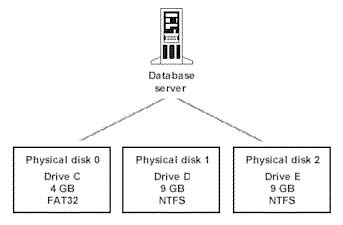
You need to create a new database named Inventory. Employees in your company will use the Inventory database to track inventory data. Users will require immediate responses to queries that help them locate where parts are stored. The tables in the database will be configured as shown in the Database Schema exhibit.
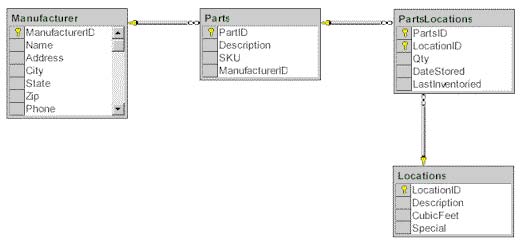
The database will consume 14 GB of disk space. You must configure the data files and transaction log to accelerate query response time.
Which two courses of action should you take? (Each correct answer represents part of the solution. Choose two.)
A. On drive C, create a transaction log.
On drive D, create a data file in the PRIMARY filegroup.
On drive E, create a data file in the SECONDARY filegroup.
B. On each drive, create a transaction log.
On each drive, create a data file in the PRIMARY filegroup.
C. On drive D, create a transaction log.
On drive E, create a data file in the PRIMARY filegroup.
D. On the PRIMARY filegroup, create all tables and all indexes.
E. On the PRIMARY filegroup, create all tables. On the SECONDARY filegroup, create all indexes.
F. On the PRIMARY filegroup, create the Parts table and its indexes.
On the SECONDARY filegroup, create all other tables and their indexes.
A,E 解析:Explanation:
A: The transaction log should be placed on a separate disk. A transaction log would not benefit of two or more disks since it is sequential. Create two data files on two separate physical disks would improve performance.
E: Separating the tables and the indexes improve performance for in particular joins.
Note: With SQL Server 2000 it is possible to create tables or indexes on specific filegroups. This allows us to control where the database's tables and indexes are physically located as filegroups can be placed on different hard drives. Placing tables in one filegroup and the table's nonclustered indexes in another filegroup on different physical disk can improve database performance because it will allow separate threads to access the tables and indexes.
However, a table and its clustered index cannot be separated into different filegroups as the clustered index determines the physical order of the data in the table. Furthermore, the transaction log should be placed on a physically separate disk. The transaction log file is written serially; therefore, using a separate, dedicated disk allows the disk heads to stay in place for the next write operation. This will further improve performance.
Incorrect Answers:
B: To improve performance, the transaction log should not be placed on the same physical disk that the tables or indexes are placed on. The transaction log file is written serially; therefore, placing it on a separate, dedicated disk allows the disk heads to stay in place for the next write operation and thus improves performance.
Furthermore, placing tables in one filegroup and the table's nonclustered indexes in another filegroup on different physical disk can improve database performance because it will allow separate threads to access the tables and indexes. However, a table and its clustered index cannot be separated into different filegroups as the clustered index determines the physical order of the data in the table.
C: The transaction log should be placed on a physically separate disk. The transaction log file is written serially; therefore, using a separate, dedicated disk allows the disk heads to stay in place for the next write operation. This will further improve performance. In this solution, the tables and their indexes are placed on the same disk. This solution thus does not take advantage of the performance improvements that can be realised through the correct utlization of the available hardware.
D: In this solution, the tables and their indexes are placed on the same disk. This solution thus does not take advantage of the performance improvements that can be realised through the correct utlization of the available hardware.
F: Greater performance gains can be realized by placing tables in one filegroup and the table’s nonclustered indexes in another filegroup on different physical disk. This will allow separate threads to access the tables and indexes.
